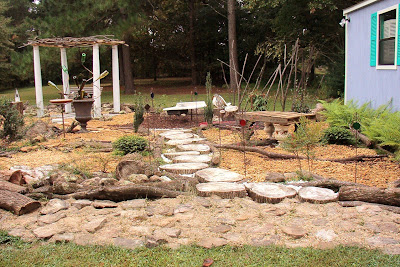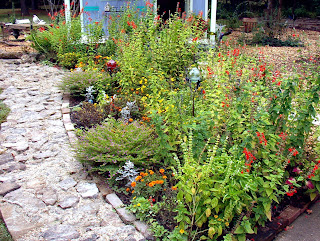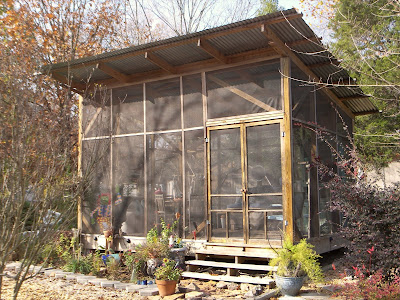Ashley's Garden
In previous generations, gardens in the rural American South were usually vegetable gardens. Alongside this tradition, a style of more ornamental gardening developed that, of necessity, reflected an economy of frugality, if not poverty. Consider the inside-out car or tractor tire, painted white, used as an ornamental planter, or the classic bottle tree. In a very real sense these were sustainable gardens, reusing materials close at hand, with plants given by neighbors and friends.

When my niece Ashley bought a new house a few years ago, she started her own garden. She adopted the Southern vernacular, and adapted it with humor and sophistication. She made her garden a playful exploration of the cliches of Southern gardening, with bottle trees, plumbing fixtures used as planters, bright colors from hand-me-down plants, all on a ground of gravel and bark mulch. This too is a garden of ideas.
The design carries visitors gently from the entrance to restful delights at the back. It has has clearly defined rooms. First is an entrance area with a tumble down reference to a Southern pergola (echoes of Tara), with fake fluted columns topped by a roof of twigs, a plastic urn (probably from Walmart or found on a roadside) with a planting of swirling copper tubing and colored bottles, a collection of upright sticks reminiscent of bean poles, and flowing lines of logs and tree rounds suggestive of the movement of water.

In front of her blue studio, where she works on her paintings and other art projects, the second room features a bed of mostly bright annuals - actually annuals to me who live in the north - but perennials in her Oxford, Mississippi climate, and serves as the entrance to her studio.
In the large, more restful room at the back Ashley built a screen house for sitting peacefully in rainstorms or partying on hot, buggy summer nights - a new take on the southern screened porch, with an unfinished wood structure and a classic rural corrugated metal roof.
 On a small site a short distance off the highway outside Oxford, Ashley's garden acknowledges the sense of place among a grove of cedars, pecans, maples, pines and beeches, and gives a traditional formula a conceptual twist that is delightful.
On a small site a short distance off the highway outside Oxford, Ashley's garden acknowledges the sense of place among a grove of cedars, pecans, maples, pines and beeches, and gives a traditional formula a conceptual twist that is delightful.
When my niece Ashley bought a new house a few years ago, she started her own garden. She adopted the Southern vernacular, and adapted it with humor and sophistication. She made her garden a playful exploration of the cliches of Southern gardening, with bottle trees, plumbing fixtures used as planters, bright colors from hand-me-down plants, all on a ground of gravel and bark mulch. This too is a garden of ideas.
The design carries visitors gently from the entrance to restful delights at the back. It has has clearly defined rooms. First is an entrance area with a tumble down reference to a Southern pergola (echoes of Tara), with fake fluted columns topped by a roof of twigs, a plastic urn (probably from Walmart or found on a roadside) with a planting of swirling copper tubing and colored bottles, a collection of upright sticks reminiscent of bean poles, and flowing lines of logs and tree rounds suggestive of the movement of water.
In front of her blue studio, where she works on her paintings and other art projects, the second room features a bed of mostly bright annuals - actually annuals to me who live in the north - but perennials in her Oxford, Mississippi climate, and serves as the entrance to her studio.
In the large, more restful room at the back Ashley built a screen house for sitting peacefully in rainstorms or partying on hot, buggy summer nights - a new take on the southern screened porch, with an unfinished wood structure and a classic rural corrugated metal roof.
James Golden